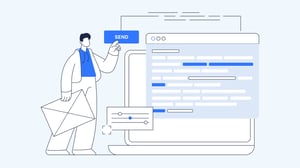6 Ways to Improve Your Sales Email Conversion Rates
Email open rates are notoriously low. In fact, the average open rate for emails up until March 2021 was just under 17%, with a click-through rate of just over 10%.
It seems pretty low, right?
The good news is that there are ways you can encourage consumers to open your emails and click through to your website. With more people opening your emails, you’ve got a higher chance of improving your sales email conversion rates.
In this article, we’ve outlined six steps you can take to improve your sales email conversion rates and increase your open rate in the process.
So, let’s get started.
6 Tips to Increase Email Conversion Rates

Follow these six best practices to increase your open rate and improve sales conversion rates:
1. Make your subject line eye-catching.
The first thing people see when your email arrives in their inbox is your subject line, so it’s no surprise that this is the first suggestion on our list. You need to make sure that your subject line stands out and encourages readers to open the email.
But how can you do that when so many emails hit people’s inboxes every day?
A great way to stand out is to make your subject line as eye-catching as possible. If you’re not sure how to do that, don’t worry. Here are some of our recommendations on how to make your subject line pop:
- Keep the character count below 60: 82% of people keep their email subject lines to 60 characters or less because most desktop emails—like Gmail and Outlook—only display up to sixty characters in a subject line.

- Consider using emojis: Using emojis in subject lines is slightly controversial among marketers. But with only 6.9% of subject lines containing emojis, what better way to stand out from the crowd than by popping an emoji in there?

- Personalize the content: If you can personalize the subject line of your email, you’ll be sure to grab the recipient’s attention. In fact, research shows that subject lines with the person’s name are more likely to be opened.
Although these suggestions are a great starting point, it’s always a good idea to find out what type of subject line works best for your audience. To do this, you might want to try some A/B testing.
It could involve trialing emojis in the subject line, changing the character count, or even amending the tone of the subject line. As a result, you’ll have a much better understanding of what resonates with your audience.
2. Use images and visuals.
How many times have you seen a giant block of text in an email and skimmed straight over it? Or started reading a newsletter, only to find yourself flicking between the headlines and not really reading the text?
We’ve all been there. Big blocks of text simply aren’t appealing.
But that’s where images and visuals can help.
Breaking up the text with visuals makes the content less overwhelming and easier to digest. Not to mention, research shows that emails with graphics have a higher open and click-through rate than those that don’t.

So, it’s clear that using visuals can have an impact on how many people open your email. Whether that’s gifs in an email, a graphic, an image, or even a video, consider placing visuals throughout your email to encourage users to read, click, and convert. Innovative technologies can also be incorporated into your email strategy. For example, you could generate high-res AI art that adds an element of mystery and intrigue to your email, encouraging users to explore the content further.
3. Create a clear CTA.
Creating a clear call-to-action (CTA) might seem like an obvious point to make, but it really can make all the difference to your conversions.
Your CTA is the driving factor that encourages people to click, so you must get it right. And without a solid CTA in place, your readers are unlikely to act, which is the whole point of sending the email in the first place.
Here’s some food for thought on your next CTA:
- Think about placement: Where you place your CTA is pretty important. You want it to be easily visible, so keeping it above the fold is always a good idea.
- Use a button: Using a CTA button keeps everything looking clean and makes it easy to spot. And if you opt for a bright color, it will stand out, too.
- Make sure your CTAs are action-oriented: For example, using phrases like “Click here,” “Buy now,” or “Find out more” all encourage people to click.
When it comes to sending your email, make sure to test the CTA links before you send them out. The last thing you want is the email going out to your entire mailing list only to find that none of them can click the CTA.
4. Optimize your emails for mobile.
The beginning of 2021 saw mobile as the most popular method for opening emails. And it’s no surprise when you think about how many people check emails on their phones.
We’d bet that you check your emails on your phone at least a few times a day, right?

As a result, it’s important to optimize your emails for mobile use. If you don’t, you could risk alienating a large part of your audience.
So what can you do to optimize your emails for mobile?
Here are a few tips:
- Test emails: Send test emails and check the formatting on multiple mobile devices.
- Make sure your links work: Double-check that any mobile forms or clickable elements work as they should.
- Make CTAs easy to click on mobile: Leave blank space around the CTA to make it easy to click.
- Keep your copy short, sweet, and concise: If your email is too busy, it’ll be hard to digest on a small screen.
- Review the subject line: We’ve already talked about creating an eye-catching subject line, and it’s no different with mobile. The only key difference is the character count. Mobile often cuts off after 25 to 30 characters, so keep this in mind.
5. Use an automated drip campaign.
If you’ve never heard of a drip campaign before, keep reading. You’re going to need it.
A drip campaign is a process that sends automated emails to leads and customers at specific stages of the customer journey. It nurtures leads throughout the sales funnel and encourages existing customers to buy from you again.
Put simply, it allows you to send targeted emails and messaging at the right moments.
Let’s use an example to put it into context:
Imagine you’re working at a credit repair company. You decide to send personalized emails to clients based on where they are in their credit repair. Whether they’ve just visited your website, reached out for a quote, or have engaged with you on social media, each stage of the journey requires a slightly different email.
You might also send emails to previous clients who have already repaired their credit. This allows you to re-engage some dormant customers and encourage previous customers to use your services again.
So how can you create your own drip campaign?
Unfortunately, there isn’t a one-size-fits-all approach. Every business has a different customer journey, so it’s up to you to figure out what that journey looks like, when you need to send automated emails, and what to include.
A great place to start is researching some automation software that can help you streamline the process. Whether that’s through a CRM platform or a specific email automation tool, you’ll want something in place to help you track the journey.
6. Track your progress.
If you want to improve your email conversion rates, the work doesn’t stop when you’ve optimized the actual email.
Real work comes into play when you review the successes and failures of your emails.
This part of the process allows you to see what went well and identify any areas of improvement going forward. With this information, you can make sure that future emails take this into account. You know what works well, what doesn’t, and you’re continually tracking customer responses.
Without continually monitoring how things are going, you risk missing an opportunity for improvement.
Create Your Next Email Campaign with Confidence
So there you have it. Now you know how you can improve your sales email conversion rates with your next email campaign. But before you finish reading, we do have one final piece of advice.
Take the best advice that works for your business.
Yes, we’ve provided you with solid guidance about increasing your conversion rates, but every business is different. What works for one company might not work for another. Ultimately, it’s up to you to use this information to find out what resonates with your audience. Take the information we’ve given you, and figure out how to use it to your advantage.
A Few (Related) Sales Posts
 Featured image: Best Cold Email Templates for B2B Sales Prospecting - Read full post: 10 Best Cold Email Templates for B2B Sales Prospecting
Featured image: Best Cold Email Templates for B2B Sales Prospecting - Read full post: 10 Best Cold Email Templates for B2B Sales Prospecting
10 Best Cold Email Templates for B2B Sales Prospecting
 Featured image: How to End a Sales Email: Best Closing Lines - Read full post: How to End a Sales Email: Closing Lines That Work Best
Featured image: How to End a Sales Email: Best Closing Lines - Read full post: How to End a Sales Email: Closing Lines That Work Best
How to End a Sales Email: Closing Lines That Work Best
 Read full post: B2B Sales Email Guide: How to Nail a Cold Email Campaign
Read full post: B2B Sales Email Guide: How to Nail a Cold Email Campaign
